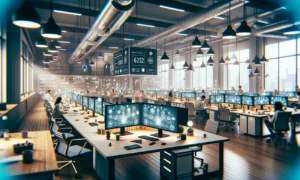Quick look back over our shoulder – Offices in 2023
Hybrid working has been dominating, and remains to do so, but polarising views on maximising time spent in the office versus fully remote policies are batted around daily. The former mainly comes from business owners, and the latter from employees who seek the ideal work-life balance after the flexibility a post-Covid world introduced.
The office itself is growing into a product many could have never predicted: Consumer-driven, amenity-rich, and thoughtfully-designed. This evolution is driving demand from businesses and subsequently urging providers and asset owners to adopt these trends to create best-in-class spaces.
2023 witnessed a new take on what a workspace means. It brought longer-term thinking and an increasing emphasis on purpose-driven environments, elements that can be threaded into the coming year. So, what do you need to know looking ahead?
Old-school thinking versus forward-thinking
In the grand scheme of things, some believe offices are all the same no matter how you dress them up. However, forward-thinking suggests that office space can be split into three main categories: Flexible, Managed, and Leased spaces. A couple of years ago, each was its own entity, but now, the lines between these are becoming increasingly blurred. The diversification of space is at a stage where matching the specific needs of a business is more accessible than ever. This is courtesy of design-led approaches and flexibility of terms and is becoming increasingly popular with the offerings of providers and asset owners.
Hospitality’s impact on the industry has increased this partnership-focus further with ‘hotelification’. This includes grand arrival experiences, high-quality interiors, enticing layouts, and exclusive amenities.
Amenities and workplace evolution
Some hold the old-school thought that amenities aren’t everything, even the best perks in the world won’t bring staff back to the office. Yet, the workplace has evolved to become a consumer product. This means thinking around what the consumers (or teams in this case) want must be considered at a greater scale than ever before. Although an office won’t be the sole reason teams want to come in, it plays a substantial role.
Even remote-first businesses have admitted a need for an office base as a collaborative hub during anchor days. Best-in-class amenities are now offered as standard across many providers and asset owners. These include on-site gyms, bars, restaurants, cafes, wellness rooms, and yoga studios, contributing to the desire to increase in-office days.
Generational influences and ethical expectations
Progressive generational groups such as Gen Z and Millennials won’t be discouraged to work from home, even with the best office on Earth, according to some old-school thinking. Yet, Gen Z is set to become one of the biggest generational groups in the workplace and, unlike prior generations, is deeply invested in the impact of their work on their personal identity.
A recent Workplace from Meta article dissected results from ThoughtExchange’s report: Gen Z At Work. It found that 96% of Gen Z employees surveyed put emphasis on the importance of feeling valued and empowered. Additionally, 79% wanted their manager to care about personal development as much as professional development. To bolster this, residing in a purpose-driven environment ranked high on the agenda in 2023. The same report notes 73% of the Gen Z workforce have high expectations for ESG (environmental, social, governance) and would leave a business if practices were not ethical. This is followed by 68% if sustainability was lacking.
Location flexibility and expansion
Desirable locations have been a driving force for office take-up. To be swayed outside of a specific location is unlikely, some say. However, a couple of years ago, a focus on renowned locations which embodied the hustle of a post-Covid world, such as the West End, was prevalent. Recently, a shift to expansion in nearby areas has taken the lead.
Although desirable central locations such as Soho will never go out of style, a focus from providers and asset owners in surrounding areas means the choice is rapidly expanding; at Kontor we are seeing plenty of interest in areas not typically sought after, such as Chancery Lane, Clerkenwell & Farringdon. Businesses have more options than ever and are usually open to exploring outside of their desired remit if it means a cost reduction, better commuting options, or enhanced space and facilities.
Flexibility within the office space
There’s an old-school thinking that there’s zero flexibility within the office; it can be too distracting. However, imagine this: You’ve briefed a self-contained office but communal meeting rooms and breakout spaces seem like an attractive perk for the team to remain dynamic. This became quite a trend last year. It’s the best solution to counteract the fight for a meeting room or phone booth when they start filling up, especially on team anchor days.
As ways of working grow in flexibility, so do offices. It’s not unusual to request a self-contained floor for privacy but still access communal areas to increase the number of potential meeting spots, network with other businesses, or just for a change of scenery. The office isn’t past us, but remote working doesn’t dominate all. Instead of centralising focus on the polarising views which – let’s face it – lack inclusivity and seem redundant in many circles, emphasis should lie on finding the right office which aligns to brand values, business roadmaps, and team requirements.



















































